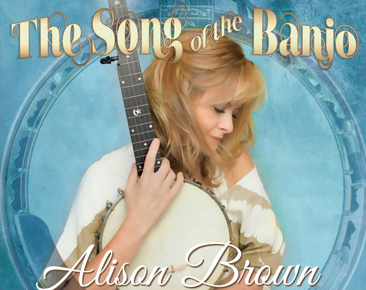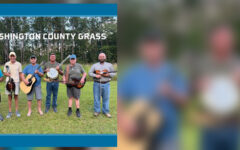
 The Song Of The Banjo is not like any banjo album you have ever heard, even if you’ve listened to Alison Brown’s prior releases. Sure, it features several of her intricate instrumentals, played to perfection, but in addition to guest vocals from a surprising cast of characters, there is a different attitude to the record, something that Brown told us was intended, right from the start.
The Song Of The Banjo is not like any banjo album you have ever heard, even if you’ve listened to Alison Brown’s prior releases. Sure, it features several of her intricate instrumentals, played to perfection, but in addition to guest vocals from a surprising cast of characters, there is a different attitude to the record, something that Brown told us was intended, right from the start.
“I wanted to make a banjo album for people who weren’t already fans of the instrument. For the uninitiated – the future banjo players of America. It’s a big undertaking, because you don’t want to leave the bluegrass lovers behind, but you want to reach people who love pop music in their comfort zone.
When I think about the banjo having been the most popular instrument in America in the late 1800s, I can’t see any reason why that couldn’t happen again.”
So starting in the planning stages, Alison began selecting material, both popish covers and melodic original numbers she could set into a comfortable instrumental setting. Not necessarily comfortable for the banjo, but easy on the ears of listeners not so acclimated to its distinctive sound.
And as an experienced producer, recording artist and label head, she knew the importance of setting goals and thinking critically about them, especially in an environment where selling recorded music has become such a challenge.
“In a market so saturated with music, you really need to have goals for a new project, and it helps to be strategic right from the beginning. Start with the result you seek, and work backwards from there.
If you going to do to spend the money and time necessary to produce a professional recording, you really should have a point to make. Not just, ‘it’s time for a new record,’ but something to say with the music, and a goal for the project to achieve.”
OK… so she’s got a vision – banjo music for non-banjo lovers – and a plan for executing it. How did it turn out?
The word I would choose to describe The Song Of The Banjo is ‘surprising.’ The choices Brown makes here are unexpected, but the biggest surprise is how well they work.
Like a banjo version of Chuck Mangione’s 1977 hit, Feels So Good. One of the rare instrumentals to make a legitimate hit on popular radio, this danceable jazz number is surely among the last on most people’s list of likely banjo covers. But as you can see in this music video, it works just fine as a duet with Hawaiian uke master, Jake Shimabukuro.
Is it bluegrass? Not by a long shot. But it is fine music performed on the banjo, without a doubt.
Is there a market for this sound? That will be determined as marketing and promotion for this record continue. But there is an obvious parallel between Mangione’s success in the late ’70s and Brown’s approach here with the 5-string. Part of how his music clicked with a general public not educated in the intricacies of jazz was that he played his instrument, the flugelhorn, so that it sounded very much like a human voice. This made it more relatable to a widespread radio audience, and easier for them to embrace.
When we suggested to Alison that on many of these tracks on The Song Of The Banjo, it felt as though she was utilizing the banjo similarly, like a voice, she owned up right away.
“I was really trying to do that. I think about John Hartford’s banjo playing so much, because he knew how to leave spaces in the music. When you try to take the banjo outside of bluegrass, you can’t just rely on the standard vocabulary of rolls and licks. You have to find a new way to play.”
For vocal assistance, Brown brought in a number of singers with a wide appeal to non-bluegrass fans. She chose Amy Ray and Emily Saliers of Indigo Girls fame to interpret Michael Martin Murphy’s Carolina In The Pines.
“Carolina In The Pines was a staple of bluegrass music for me. It was always played at jams in southern California where I grew up. I always liked the song, and am a big fan of the Indigo Girls. I have collaborated with them many times.”
Another, I’ll Never Fall In Love Again, a very popular show tune in the late ’60s, was selected for the album following a dinner conversation between Alison and her husband, Garry, and Colin Hay, former vocalist with Australia’s Men At Work. As the dinner continued, discussion came around to Burt Bacharach, and how much both Alison and Colin loved his music. Soon a plan was hatched for Colin to sing the song on the album, with quite a different arrangement that what so many of us remember from Dione Warwick’s iconic version from 1969.
She also asked blues man Keb’ Mo’ to sing Marvin Gaye’s soul anthem, What’s Goin’ On? Can you imagine that one backed by banjo and fiddle? With piano and drums as well. Alison said that the idea for the song came first, as Garry had always loved it, and they realized that as popular as the song had been, it had never had a life in the roots music world. Her jazzy banjo really takes the lead here, even with passionate vocals from Keb’.
Other pop covers get an instrumental treatment, like Time After Time, a #1 song for Cyndi Lauper in 1984. The banjo takes the vocal lead part in a very poppy arrangement, not terribly unlike the original. Dance With Me was also a radio hit in 1975 for Orleans, written by John and Johanna Hall. Here it’s a feature for banjo and dobro, with Rob Ickes doing the honors. Alison said that she always liked fooling around with this one on the banjo in D, and that this cover started at a session with she and Rob messing with it.
The remainder of the tracks are her own compositions, centered on the banjo of course. But she said that many of those were written to fill a slot on the live shows she does with her own group, The Alison Brown Quartet. Airish was written when Garry suggested that they should have a piece with something of a shuffle feel, and The Moon In Molly’s Eyes came about because they were looking for something with a bossa nova groove. Both are lovely tunes that suit the banjo perfectly, and Brown’s light tough to a T.
Musette For The Last Fret has a lovely light classical feel, and though it is played effortlessly as a banjo/piano duet, tremendous technical proficiency is required to pull this off on the banjo.
I suppose we’ll have to wait and see if this record brings non-banjo lovers over en masse. The music has the potential to do so, lovingly and meticulously performed, and arranged to serve its purpose.
With holiday gift-giving just around the corner, The Song Of The Banjo might be just the thing for friends and family who don’t yet cotton to the banjo and bluegrass music. Sometimes you have to bring them around slowly.







